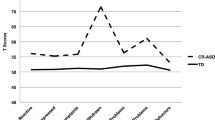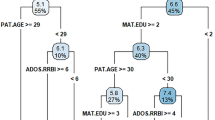Abstract
Quantitative variations in score profiles from the parent version of the PDD Behavior Inventory (PDDBI) were examined in young Autism and PDD-NOS groups defined by ADOS-G and ADI-R criteria, relative to a not spectrum (NS) group of similar age. Both the Autism and the PDD-NOS group profiles markedly differed from the NS group. The most sensitive measures of group differences were those domain and composite scores that assessed social communication competence, as well as the overall Autism Composite score. Sensitivity, specificity and positive and negative predictability measures were quite good for these measures. It was concluded that the PDDBI is useful in assisting in the differential diagnosis of autism spectrum disorder.

Similar content being viewed by others
References
American Psychiatric Association. (2000). Diagnostic and statistical manual of mental disorders fourth edition text revision. DC: Washington.
Chauhan, A., Chauhan, V., Brown, W. T., & Cohen, I. L. (2004a). Oxidative stress in autism: Increased lipid peroxidation and reduced serum levels of ceruloplasmin and transferrin—the antioxidant proteins. Life Sciences, 75, 2539–2549.
Chauhan, V., Chauhan, A., Cohen, I. L., Brown, W. T., & Sheikh, A. (2004b). Alteration in amino-glycerophospholipids levels in the plasma of children with autism: A potential biochemical diagnostic marker. Life Sciences, 74, 1635–1643.
Cohen, I. L. (2003). Criterion-related validity of the PDD behavior inventory. Journal of Autism and Developmental Disorders, 33, 47–53.
Cohen, I. L., Liu, X., Schutz, C., White, B. N., Jenkins, E. C., Brown, W. T., et al. (2003a). Association of autism severity with a monoamine oxidase A functional polymorphism. Clinical Genetics, 64, 190–197.
Cohen, I. L., Schmidt-Lackner, S., Romanczyk, R., & Sudhalter, V. (2003b). The PDD behavior inventory: A rating scale for assessing response to intervention in children with PDD. Journal of Autism and Developmental Disorders, 33, 31–45.
Cohen, I. L., & Sudhalter, V. (2005). The PDD behavior inventory. Lutz, FL: Psychological Assessment Resources.
Cohen, I. L., & Tsiouris, J. (2006). Maternal recurrent mood disorders and high-functioning autism. Journal of Autism and Developmental Disorders, 36, 1077–1078.
Gotham, K., Risi, S., Pickles, A., & Lord, C. (2007). The autism diagnostic observation schedule: Revised algorithms for improved diagnostic validity. Journal of Autism and Developmental Disorders, 37, 613–627.
Green, D. M., & Swets, J. A. (1966). Signal detection theory and psychophysics. New York: Wiley.
Griffiths, R. (1984). The abilities of young children: A comprehensive system of mental measurement for the first eight years of life. Bucks, UK: A.R.I.C.D.The Test Agency Limited. Revised ed.
Klassen, A. F., Lee, S. K., Raina, P., Chan, H. W., Mattthew, D., & Brabyn, D. (2004). Health status and health-related quality of life in a population-based sample of neonatal intensive care graduates. Pediatrics, 113, 594–600.
Liu, X., Novosedik, N., Wang, A., Hudson, M., Cohen, I., Chudley, A. E., et al. (2009). The DLX1 and DLX2 genes and susceptibility to autism spectrum disorders. European Journal of Human Genetics, 17, 228–235.
Lord, C., Risi, S., Lambrecht, L., Cook, E. H., Jr., Leventhal, B. L., DiLavore, P. C., et al. (2000). The autism diagnostic observation schedule-generic: A standard measure of social and communication deficits associated with the spectrum of autism. Journal of Autism and Developmental Disorders, 30, 205–223.
Lord, C., Rutter, M., & Le Couteur, A. (1994). Autism diagnostic interview-revised: A revised version of a diagnostic interview for caregivers of individuals with possible pervasive developmental disorders. Journal of Autism and Developmental Disorders, 24, 659–685.
Maimburg, R. D., & Vaeth, M. (2006). Perinatal risk factors and infantile autism. Acta Psychiatrica Scandinavia, 114, 257–264.
Reaven, J. A., Hepburn, S. L., & Ross, R. G. (2008). Use of the ADOS and ADI-R in children with psychosis: Importance of clinical judgment. Clinical Child Psychology and Psychiatry, 13, 81–94.
Risi, S., Lord, C., Gotham, K., Corsello, C., Chrysler, C., Szatmari, P., et al. (2006). Combining information from multiple sources in the diagnosis of autism spectrum disorders. Journal of the American Academy of Child and Adolescent Psychiatry, 45, 1094–1103.
Rutter, M., Le Couteur, A., & Lord, C. (2003). Autism diagnostic interview-revised—WPS. Los Angeles: Western Psychological Services. WPS ed.
SPSS. (2006). SPSS 15 for windows. Chicago: SPSS.
Statsoft. (2008). Statistica. Tulsa, OK: Statsoft.
Szatmari, P., Georgiades, S., Bryson, S., Zwaigenbaum, L., Roberts, W., Mahoney, W., et al. (2006). Investigating the structure of the restricted, repetitive behaviours and interests domain of autism. Journal of Child Psychology and Psychiatry, 6, 582–590.
Walker, D. R., Thompson, A., Zwaigenbaum, L., Goldberg, J., Bryson, S. E., Mahoney, W. J., et al. (2004). Specifying PDD-NOS: a comparison of PDD-NOS, Asperger syndrome, and autism. Journal of the American Academy of Child and Adolescent Psychiatry, 43, 172–180.
Youden, W. J. (1950). Index for rating diagnostic tests. Cancer, 3, 32–35.
Acknowledgments
The authors are grateful to the many parents and teachers who participated in this project. We also wish to thank Michael Flory for his statistical advice and acumen, and to the following colleagues who helped with the initial review of the PDDBI: Mary Coleman, Allan Reiss, Raymond Romanczyk, Susan Schmidt-Lackner, and Wayne Silverman. This research was supported by funds from the New York State Office of Mental Retardation and Developmental Disabilities, the NYS Special Legislative Grant for Autism Research, and by grant #PO1-HD047281-04 to Judith M. Gardner. The PDDBI generates a royalty, 50% of which is used to support research at the Institute with the other 50% distributed to the authors of the PDDBI.
Author information
Authors and Affiliations
Corresponding author
Rights and permissions
About this article
Cite this article
Cohen, I.L., Gomez, T.R., Gonzalez, M.G. et al. Parent PDD Behavior Inventory Profiles of Young Children Classified According to Autism Diagnostic Observation Schedule-Generic and Autism Diagnostic Interview-Revised Criteria. J Autism Dev Disord 40, 246–254 (2010). https://doi.org/10.1007/s10803-009-0863-8
Received:
Accepted:
Published:
Issue Date:
DOI: https://doi.org/10.1007/s10803-009-0863-8




